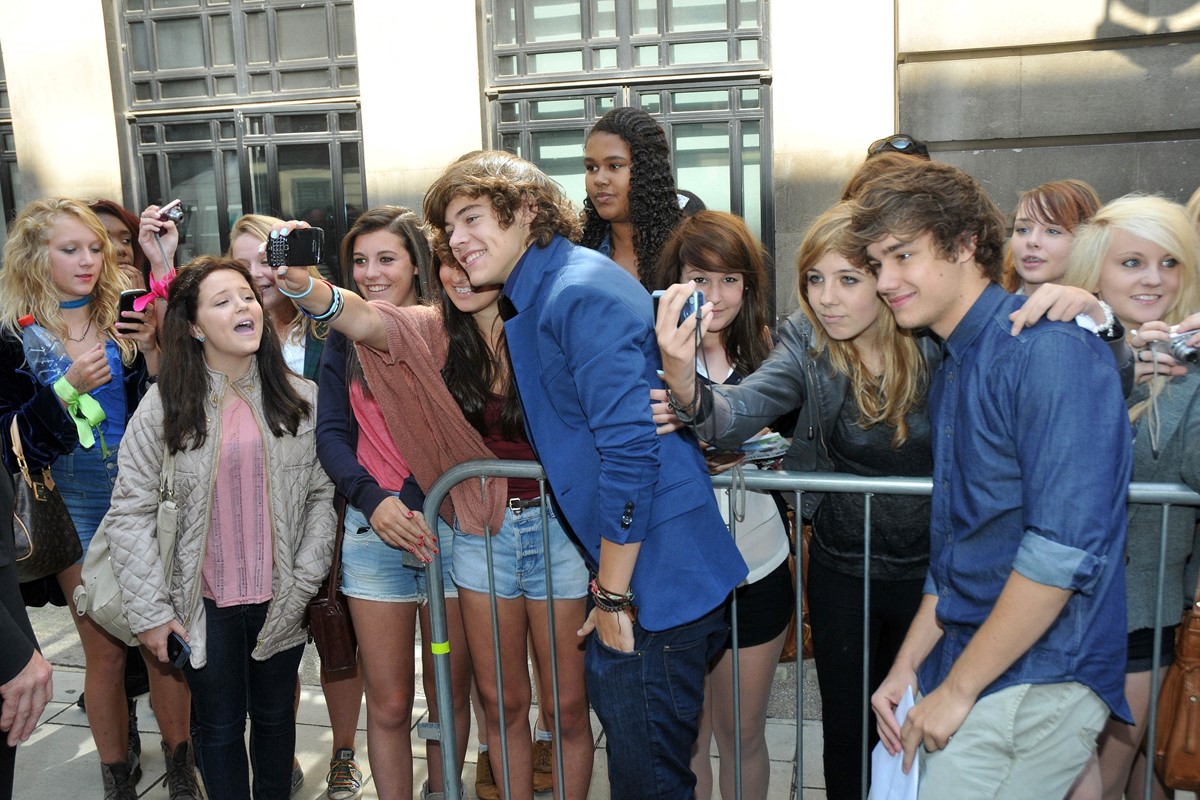
Rewrite
Since Liam Payne tragically died at the age of 31 last week, many who grew up during One Direction’s prime have been reminiscing about what, on the surface, seems to be a simpler era of pop culture. Fans are revisiting old albums, fawning over the clumsiness of their earliest performances and even looking back fondly on the unhinged fanfiction and memes that once littered the internet. But at the centre of this outpouring of grief-tainted nostalgia is one realisation that seems painfully stark in hindsight: at the very height of their fame, they were so unbelievably young.
Teenagers and young adults have helmed some of the world’s biggest cultural movements. Yet, in the wake of yet another tragedy, it’s abundantly clear that there’s a stark difference between allowing adolescents to create art and transforming them into purpose-built, multi-billion dollar brands.
It’s not that it’s a new thing – the presence of teenagers and children in the entertainment industry pre-dates colour TV – but the last two decades have seen them take centre stage in culture following Disney Channel’s marketing shift towards adolescents in the late 90s. Since then, we’ve seen a revolving door of baby-faced stars, trading their youth for brief stints at fame and lining the pockets of vampiric industry execs.
funniest one direction performance of all time just turned 14 years old how is that possible I’m sick pic.twitter.com/0AIu0kA7c7
— katelyn (@noitskatelyn) October 18, 2024
Their success mostly lies in their constructed relatability. One Direction’s USP lay in the fact they were “five normal lads”, despite the fact that their collective net worth eclipsed some small nations. Yet they’re far from the only ones of their generation to be marketed as such. Two years prior to their This Is Us documentary, Justin Bieber’s Never Say Never premiered, promising an unfiltered glimpse into the life of the biggest teen star at the time.
The film, which grossed $99 million worldwide, followed a 16-year-old Bieber in the run-up to his sold-out Madison Square Garden concert. But despite the documentary positioning him as a hard-working, pop-underdog and “ordinary kid”, looking back now it seems more of a series of interviews with the many adults on his payroll, justifying subjecting a child to immense scrutiny and a chaotic work schedule. It’s an even eerier watch today in light of the singer’s more recent admissions that he has battled with depression, anxiety and addiction as a result of becoming famous so young.
So how exactly does fame impact teenagers? Psychotherapist Nicholas Rose argues that excessive success at a young age removes the normalcy that is key to our development as human beings. “If a young person is already seen as different in a particular way or misses out on the experiences that others routinely have then this can impact on how they feel in the world, how they view it and therefore their relationship with both themselves and others,” he says. “Isolation, loneliness, pressure, emptiness and fear are feelings that can weigh heavily on famous people.”
Research suggests the pre-frontal cortex – where consequences, decisions, reasoning and other higher-order functioning occurs – doesn’t fully develop until the age of 25 […] a younger person is likely to be more malleable
For teen stars in particular, a lack of life experience paired with a longing to make their dreams come true can be a recipe for disaster. “There may be a greater sense of desire in a young person ‘really wanting to make it work’, which can also lead them to ignore red flags, and the voices of those trying to help,” says psychologist Dr Audrey Tang. “Add to that the physiological research which suggests the pre-frontal cortex – where consequences, decisions, reasoning and other higher-order functioning occurs – doesn’t fully develop until the age of 25, and a younger person is likely to be more malleable.”
This was an issue highlighted in Demi Lovato’s recent documentary Child Star, which outlined the lasting mental damage of being both a public figure and breadwinner as a child. In one particularly harrowing moment, Lovato ran through the work schedule she had as a teenager, which included back-to-back movie tapings, albums and world tours – commitments she had to uphold alongside a squeaky-clean brand image. “Those words should never be put together – teenage role model,” she said in the film. Later it’s also revealed that, in its prime, Hannah Montana generated billions of dollars for Disney Channel in merchandising and licensing agreements – all while having a 13-year-old Miley Cyrus at its centre.
During One Direction’s fleeting time as a band, they had similarly intense schedules. They toured relentlessly, released five studio albums in four years and made millions for their label through an excessive catalogue of merch. In 2013, when Payne was just 20 years old, One Direction became the first boyband to gross $1 billion.
the process of becoming a child star is in itself a largely abusive process and the effects of the industry on a person ripple out into so much pain around them, by their own actions or otherwise. sick sick industry.
— joanie (@laracroftbarbie) October 17, 2024
At the time, a slew of saccharine singles about living life to the fullest, having a crush and being best friends masked perhaps a gloomier reality, with Payne admitting in 2019 that he turned to alcohol to cope with the pressures of fame while in the band. Before they could even vote they were transformed into a lucrative brand, catapulted to unimaginable success and offered up as public property for tabloids and social media to criticise. For Payne, this publicity began when he first auditioned for The X Factor at 14 years old and continues to rob him of privacy in death – only moments after the news broke, photos of his body were published by TMZ, and already a Hulu special dissecting his final hours has been announced.
In response, fans have proposed “Liam’s Law”, a legislation that would force the industry to take accountability for protecting their young talent. Elsewhere, figures in the music industry – including songwriter Guy Chambers – have suggested that under-18s should be prohibited from joining pop groups entirely.
“The entertainment industry contains a great deal of experience on the impacts of fame, which if it does care about mental health, can be put to very good use,” says Rose. “In practice, this means training industry executives in mental health and concepts like ethics, consent, power, emotional well-being and critical thinking.”
But can any safeguarding truly protect a teenager from mass exposure and immense career highs before they’re physically able to process them? “Personally I don’t think the answer is always psychological,” says Dr Tang. “You can have access to as many psychologists as you like, but if it’s your own management team exploiting you – and the people around them are letting them do it – I’m not sure how much ‘counselling’ will help.”
visited the liam payne memorial today in hyde park 🕊️🤍 pic.twitter.com/0QcC2N6bIz
— ciara (@cicizza) October 23, 2024
Looking back at the early 00s reality TV that spawned One Direction in the first place, it’s increasingly clear that young people, often from working-class backgrounds, were routinely subject to this exploitation in the name of Saturday night entertainment. Since Payne’s death, many of his fellow X Factor contestants have spoken out about the lack of care they received while competing on the show. And although The X Factor ended in 2018, earlier this year Simon Cowell announced he would be launching a new reality show to “find the next One Direction”. An online casting call invited boys aged between 16-18 to audition for the chance to become a “global superstar”.
Head to London’s Hyde Park today and One Direction’s everlasting superstar status is evident. You’ll still find mourners gathered around the Peter Pan statue, which has become a memorial for Payne. A glance at the damp cheeks, faded merch and 15-year-old friendship bracelets worn by those laying flowers and handwritten notes reveals how important One Direction was to a whole generation.
But now, as the music industry reckons with yet another young life tragically lost, maybe it will finally learn from its most fatal mistakes and stop preying on teens for profit.
in HTML format, including tags, to make it appealing and easy to read for Japanese-speaking readers aged 20 to 40 interested in fashion. Organize the content with appropriate headings and subheadings (h1, h2, h3, h4, h5, h6), translating all text, including headings, into Japanese. Retain any existing
tags from
Since Liam Payne tragically died at the age of 31 last week, many who grew up during One Direction’s prime have been reminiscing about what, on the surface, seems to be a simpler era of pop culture. Fans are revisiting old albums, fawning over the clumsiness of their earliest performances and even looking back fondly on the unhinged fanfiction and memes that once littered the internet. But at the centre of this outpouring of grief-tainted nostalgia is one realisation that seems painfully stark in hindsight: at the very height of their fame, they were so unbelievably young.
Teenagers and young adults have helmed some of the world’s biggest cultural movements. Yet, in the wake of yet another tragedy, it’s abundantly clear that there’s a stark difference between allowing adolescents to create art and transforming them into purpose-built, multi-billion dollar brands.
It’s not that it’s a new thing – the presence of teenagers and children in the entertainment industry pre-dates colour TV – but the last two decades have seen them take centre stage in culture following Disney Channel’s marketing shift towards adolescents in the late 90s. Since then, we’ve seen a revolving door of baby-faced stars, trading their youth for brief stints at fame and lining the pockets of vampiric industry execs.
funniest one direction performance of all time just turned 14 years old how is that possible I’m sick pic.twitter.com/0AIu0kA7c7
— katelyn (@noitskatelyn) October 18, 2024
Their success mostly lies in their constructed relatability. One Direction’s USP lay in the fact they were “five normal lads”, despite the fact that their collective net worth eclipsed some small nations. Yet they’re far from the only ones of their generation to be marketed as such. Two years prior to their This Is Us documentary, Justin Bieber’s Never Say Never premiered, promising an unfiltered glimpse into the life of the biggest teen star at the time.
The film, which grossed $99 million worldwide, followed a 16-year-old Bieber in the run-up to his sold-out Madison Square Garden concert. But despite the documentary positioning him as a hard-working, pop-underdog and “ordinary kid”, looking back now it seems more of a series of interviews with the many adults on his payroll, justifying subjecting a child to immense scrutiny and a chaotic work schedule. It’s an even eerier watch today in light of the singer’s more recent admissions that he has battled with depression, anxiety and addiction as a result of becoming famous so young.
So how exactly does fame impact teenagers? Psychotherapist Nicholas Rose argues that excessive success at a young age removes the normalcy that is key to our development as human beings. “If a young person is already seen as different in a particular way or misses out on the experiences that others routinely have then this can impact on how they feel in the world, how they view it and therefore their relationship with both themselves and others,” he says. “Isolation, loneliness, pressure, emptiness and fear are feelings that can weigh heavily on famous people.”
Research suggests the pre-frontal cortex – where consequences, decisions, reasoning and other higher-order functioning occurs – doesn’t fully develop until the age of 25 […] a younger person is likely to be more malleable
For teen stars in particular, a lack of life experience paired with a longing to make their dreams come true can be a recipe for disaster. “There may be a greater sense of desire in a young person ‘really wanting to make it work’, which can also lead them to ignore red flags, and the voices of those trying to help,” says psychologist Dr Audrey Tang. “Add to that the physiological research which suggests the pre-frontal cortex – where consequences, decisions, reasoning and other higher-order functioning occurs – doesn’t fully develop until the age of 25, and a younger person is likely to be more malleable.”
This was an issue highlighted in Demi Lovato’s recent documentary Child Star, which outlined the lasting mental damage of being both a public figure and breadwinner as a child. In one particularly harrowing moment, Lovato ran through the work schedule she had as a teenager, which included back-to-back movie tapings, albums and world tours – commitments she had to uphold alongside a squeaky-clean brand image. “Those words should never be put together – teenage role model,” she said in the film. Later it’s also revealed that, in its prime, Hannah Montana generated billions of dollars for Disney Channel in merchandising and licensing agreements – all while having a 13-year-old Miley Cyrus at its centre.
During One Direction’s fleeting time as a band, they had similarly intense schedules. They toured relentlessly, released five studio albums in four years and made millions for their label through an excessive catalogue of merch. In 2013, when Payne was just 20 years old, One Direction became the first boyband to gross $1 billion.
the process of becoming a child star is in itself a largely abusive process and the effects of the industry on a person ripple out into so much pain around them, by their own actions or otherwise. sick sick industry.
— joanie (@laracroftbarbie) October 17, 2024
At the time, a slew of saccharine singles about living life to the fullest, having a crush and being best friends masked perhaps a gloomier reality, with Payne admitting in 2019 that he turned to alcohol to cope with the pressures of fame while in the band. Before they could even vote they were transformed into a lucrative brand, catapulted to unimaginable success and offered up as public property for tabloids and social media to criticise. For Payne, this publicity began when he first auditioned for The X Factor at 14 years old and continues to rob him of privacy in death – only moments after the news broke, photos of his body were published by TMZ, and already a Hulu special dissecting his final hours has been announced.
In response, fans have proposed “Liam’s Law”, a legislation that would force the industry to take accountability for protecting their young talent. Elsewhere, figures in the music industry – including songwriter Guy Chambers – have suggested that under-18s should be prohibited from joining pop groups entirely.
“The entertainment industry contains a great deal of experience on the impacts of fame, which if it does care about mental health, can be put to very good use,” says Rose. “In practice, this means training industry executives in mental health and concepts like ethics, consent, power, emotional well-being and critical thinking.”
But can any safeguarding truly protect a teenager from mass exposure and immense career highs before they’re physically able to process them? “Personally I don’t think the answer is always psychological,” says Dr Tang. “You can have access to as many psychologists as you like, but if it’s your own management team exploiting you – and the people around them are letting them do it – I’m not sure how much ‘counselling’ will help.”
visited the liam payne memorial today in hyde park 🕊️🤍 pic.twitter.com/0QcC2N6bIz
— ciara (@cicizza) October 23, 2024
Looking back at the early 00s reality TV that spawned One Direction in the first place, it’s increasingly clear that young people, often from working-class backgrounds, were routinely subject to this exploitation in the name of Saturday night entertainment. Since Payne’s death, many of his fellow X Factor contestants have spoken out about the lack of care they received while competing on the show. And although The X Factor ended in 2018, earlier this year Simon Cowell announced he would be launching a new reality show to “find the next One Direction”. An online casting call invited boys aged between 16-18 to audition for the chance to become a “global superstar”.
Head to London’s Hyde Park today and One Direction’s everlasting superstar status is evident. You’ll still find mourners gathered around the Peter Pan statue, which has become a memorial for Payne. A glance at the damp cheeks, faded merch and 15-year-old friendship bracelets worn by those laying flowers and handwritten notes reveals how important One Direction was to a whole generation.
But now, as the music industry reckons with yet another young life tragically lost, maybe it will finally learn from its most fatal mistakes and stop preying on teens for profit.
and integrate them seamlessly into the new content without adding new tags. Ensure the new content is fashion-related, written entirely in Japanese, and approximately 1500 words. Conclude with a “結論” section and a well-formatted “よくある質問” section. Avoid including an introduction or a note explaining the process.


